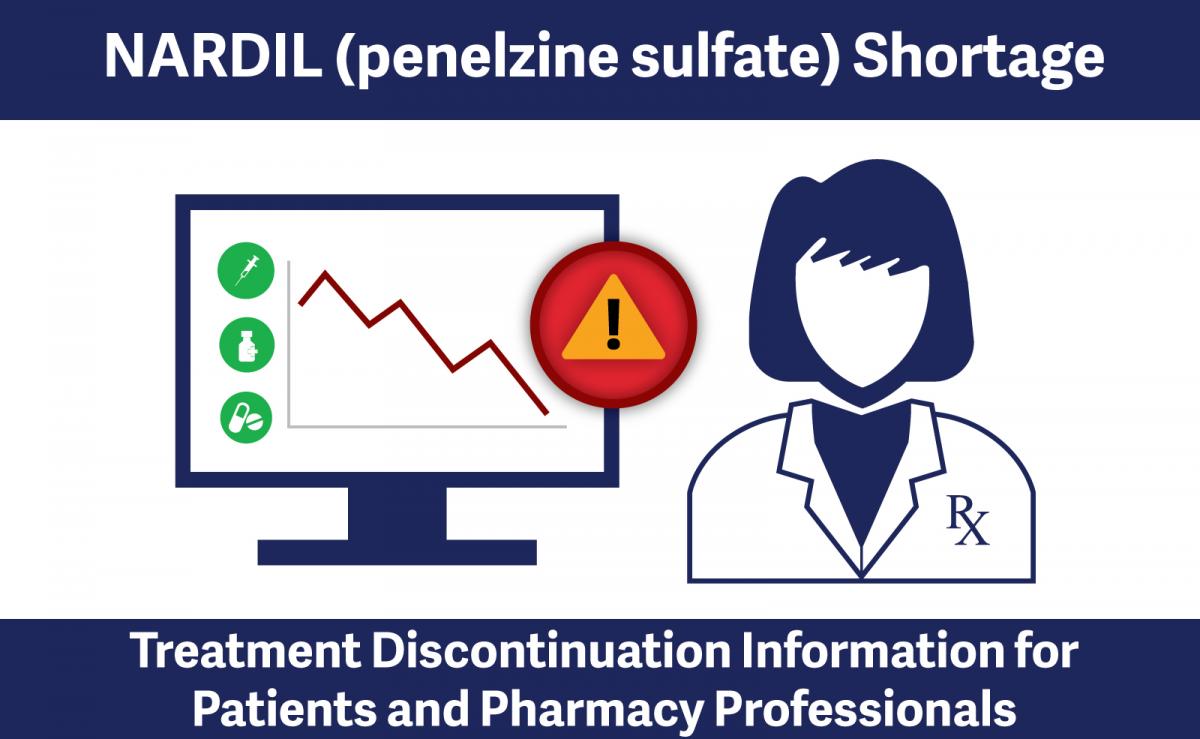NARDIL (phenelzine sulfate) Shortage
Treatment Discontinuation Information for Patients and Pharmacy Professionals
|
The following content has been adapted from a Recall and Safety Alert published by Health Canada and Important Safety Information on NARDIL. |
Due to an ongoing global shortage of the active ingredient, the availability of NARDIL (phenelzine sulfate) in Canada has decreased and the resupply date is unknown at this point.
Treatment Discontinuation Information for PatientsBefore patients stop taking NARDIL, they should talk to their healthcare professional. Patients should contact their healthcare professional as soon as possible to discuss how to safely discontinue NARDIL to minimize discontinuation symptoms and understand which symptoms require medical attention. |
The ongoing shortage affects the following dosage strengths and the corresponding DIN.
| NAME | DIN |
|---|---|
| NARDIL, Phenelzine Sulfate Tablets USP, 15mg | 00476552 |
Health Canada, in partnership with health care system stakeholders, is working with EFRA Canada 2012 Inc. to help minimize the impact of this shortage on Canadians.
NARDIL is a potent monoamine oxidase inhibitor (MAOI) indicated for the treatment of depression where anxiety or fear is the main symptom and treatment with other drugs has failed.
Information for Patients
Do not stop taking NARDIL unless your healthcare professional tells you to. Sudden discontinuation of NARDIL can cause serious side-effects within one to three days.
Patients are advised to contact their health care professional and seek medical advice as soon as possible should they experience these side effects or an exacerbation of their underlying disease.
The College does not regulate the supply or manufacture of drugs. All patients who are treated with NARDIL should consult their pharmacist, physician or healthcare provider as soon as possible in order to discuss alternative treatment options.
There is a global shortage of NARDIL and based on current available information, the Canadian product manufacturer cannot guarantee a steady supply in the future.
Before patients stop taking NARDIL, they need to talk to their healthcare professional. Patients should discuss with their healthcare professional how to safely discontinue NARDIL to minimize discontinuation of symptoms and understand what symptoms require medical attention.
Information for Pharmacy Professionals
Treatment Discontinuation Information for Pharmacy ProfessionalsPharmacists currently involved in the administration of NARDIL should begin to transition patients to alternate treatment options immediately. Treatment discontinuation should be gradual, and a 'wash out' period of at least 10 days is necessary after discontinuation of NARDIL and before the start of the new treatment. BC Drug and Poison Information Centre (DPIC)DPIC is aware of this issue and available to provide pharmacists with specifically tailored recommendations for transitioning patients to alternate treatment options. Contact the BC Drug and Poison Information Centre at: 1-866-298-5909 or 604-707-2787 (local) Note: This line is for registered health professionals only. |
Abrupt withdrawal of NARDIL can be associated with an uncommon withdrawal syndrome. Signs and symptoms of this syndrome generally commence 24 to 72 hours after drug discontinuation and may range from vivid nightmares with agitation to frank psychosis and convulsions. This syndrome generally responds to reinstitution of low-dose NARDIL therapy followed by cautious downward titration and discontinuation.
Healthcare professionals are advised to:
- Ensure no new patients are started on NARDIL
- Initiate switching patients taking NARDIL to an alternative treatment
- Avoid abrupt discontinuation of NARDIL treatment to prevent withdrawal syndrome, which can be serious. Treatment discontinuation should be gradual, and a ‘wash out’ period of at least 10 days is necessary after discontinuation of NARDIL and before the start of the new treatment.
- Monitor patients closely when taking patients off NARDIL
Additional Resources
- Important Safety Information on NARDIL (phenelzine sulfate) Shortage (ERFA)
- NARDIL (phenelzine sulfate) Shortage (Health Canada)
- Product Monograph: NARDIL* Phenelzine Sulfate Tablets USP 15 mg
- BC Drug and Poison Information Centre
- Drug Shortages Canada
- Adverse Reaction Reporting
- Recalls and Safety Alerts Database
